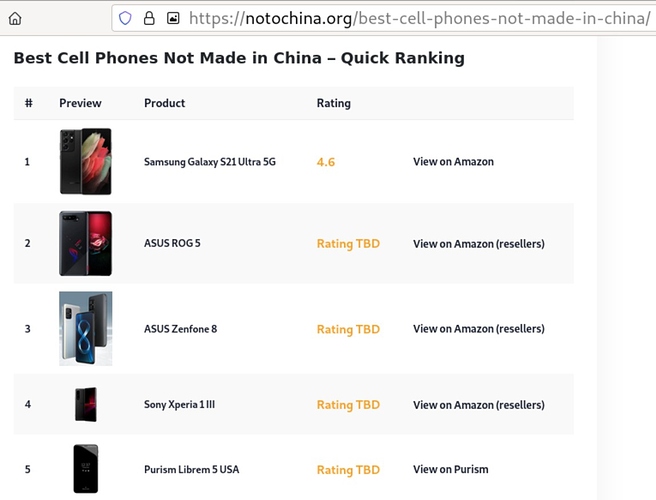I try to take the long view when thinking about this problem. As I see it, AOSP derivatives (Calyx OS, /e/, GrapheneOS, LineageOS, etc) are always going to be dependent on Google, and Google can effectively kill them off simply by deciding to stop releasing some critical bits of AOSP under the Apache 2.0 license, and that might happen if AOSP security phones ever start to gain any significant market share that encroaches on Google’s territory.
As I see it, AOSP derivatives are the best choice for anyone who needs a functional privacy phone today, but I can’t see them ever being sold by the existing phone OEMs, due to the rules of the Open Handset Alliance, and licensing for Android and Google Web Services. AFAIK, phone OEMs that sell Android phones can’t also sell AOSP-derivative phones, because many of the derivatives would violate the Open Handset Alliance’s rules against using forks of Android, since they can’t pass the Android compliance tests. Google can also refuse to license its web services to phone OEMs, so they can’t afford to piss off Google.
Linux phones don’t face the same restrictions, so they might actually get adopted by phone OEMs, without threatening their existing Android sales. At this point, however, mobile Linux needs a lot of dev work, and the only companies willing to pay developers to work on mobile Linux are Purism and Jolla (and Blue Systems to a very limited extent). Jolla and its Sailfish OS will never go anywhere, which is why every phone OEM which has tried to market it, gave up after 2 models. I also don’t see any future for poorly-maintained oFono, which is why it was so important for Purism to pay for some critical bits to be added to ModemManager so it could be used for mobile telephony.
Sailfish OS is a dead end because the community will never embrace the proprietary Silica interface, and it is saddled with oFono. I honestly dont know how Jolla manages to stay in business. No company is going to want to use Tizen’s Flora license, and Samsung has given up on Tizen for mobile devices, so it is also a dead end. WebOS is no longer being developed for mobile devices, so LuneOS is also a dead end. Firefox OS is doing fine in proprietary KaiOS, but it is becoming another platform for Surveillance Capitalism with investment and apps from Google. Ubuntu Touch/Lomiri simply doesn’t have the volunteers at UBports to maintain its mountain of siloed code. That leaves us with just Plasma Mobile and Phosh as viable mobile interfaces, and it is clear from the PinePhone users survey by PINE64 that Phosh is doing better than Plasma Mobile because Purism is paying developers to work on it.
As much as I enjoy fiddling with the PinePhone, the fact that it is not getting support for its hardware added to the mainline Linux kernel illustrates the problems with relying on 100% volunteer labor. If we are serious about ever seeing mobile Linux ever become a viable alternative to Android/iOS, we need paid developers working on it, because critical libraries like libcamera don’t get developed on their own.
The hard question for people who pre-ordered the Librem 5 is whether they are willing to put up with the endless delays and poor business practices of Purism. The two dozen previous attempts at mobile Linux over the last two decades were business failures, so I don’t think it is fair to attribute all of Purism’s problems with the L5 to the company. Purism was facing very steep odds from the beginning, and frankly Purism made better technical decisions than its predecessors in my opinion. As I see it, Purism is the only realistic game in town to truly make mobile Linux a viable alternative, and I don’t see any benefit to driving it out of business, because the chance that another company will arise to take its place developing mobile Linux is next to nil.
The problem is that many who preordered the L5 didn’t sign up for the arduous jouney that is required to make mobile Linux a viable alternative. They signed up for the marketing of the L5 as a functional replacement for their existing smartphone. Purism needed a large number of pre-orders to pay for the development of the L5, because it wasn’t a corporation with deep pockets, so it needed crowd funding from the community, but it wouldn’t have raised much money if it had been more upfront in its marketing about the timeline and software development that was needed for mobile Linux.
As much as Purism’s marketing frustrates me, I understand why Purism did it. From the outside, it is impossible for me to know whether Purism was acting unethically or trying to avoid bankruptcy when it decided to retroactively change its refund policy and has kept delaying the repayment of refunds. All I can know for sure is that mobile Linux needs Purism’s dev work on Phoc, Phosh, Calls, Chatty, libhandy, libadwaita, libcamera, etc., and the quarter million lines of new code that Purism has created for the Librem 5 wouldn’t have happened with purely volunteer labor.

